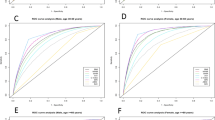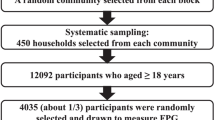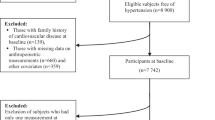Abstract
Objective
Anthropometric indices to obesity were evaluated as predictors of metabolic syndrome risk factors. Our purpose was to explore an optimal or more reliable anthropometric indicator and optimal cut-off points for obesity on metabolic syndrome in Chinese adults.
Participants and methods
The survey was conducted involving 2947 participants, aged 20 or above with cross-sectional study of population. The predictive validity and optimal cut-off values were analyzed by receiver operating characteristic (ROC) curves, area under curve (AUC) and the largest Youden’s index (sensitivity + specificity −1) by gender group, respectively. Kappa value showed diagnostic consistency.
Results
(1) According to the criteria of CDS 2004, IDF 2005 and AHA/NHLBI 2005, the prevalence of metabolic syndrome was 10.32%, 9.64% and 16.12% respectively, which indicated that the prevalence was higher in men than in women and increased with age (P < 0.05). (2) The BMI, WC, WHR and WHtR in metabolic syndrome patients were greater than those in healthy volunteers and the indices in men were higher than those in women. (3) With adjusted age and gender, the partial correlation coefficient for BMI-WC, BMI-WHR and BMI-WHtR was 0.7991, 0.5278 and 0.8196, respectively (P < 0.05). (4) The area under curves (AUCs) of receiver operating characteristic (ROC) curves for WHtR was larger (P < 0.05) than that for WC and WHR. The cut-point of WHtR was approximately 0.5 in both genders with a satisfactory balance between sensitivity and specificity, where the Kappa (κ) value for WHtR-BMI was higher than that for WHtR-WHR, and WHtR-WC.
Conclusions
The results indicated that WHtR might be an optimal anthropometric predictor of metabolic syndrome risk factors and the cut-point of WHtR was approximately 0.50 in both genders of Chinese adults.
Similar content being viewed by others
References
Sam S, Haffner S, Davidson MH, D’Agostino RB, Sr., Feinstein S, Kondos G, Perez A, Mazzone T: Relation of abdominal fat depots to systemic markers of inflammation in type 2 diabetes. Diabetes Care 2009, 32: 932–937.
Celik T, Iyisoy A, Yuksel UC, Isik E: The role of abdominal obesity and weight gain since adolescence in early atherosclerosis. Int J Cardiol 2009, 132: 263–264; author reply 264–265.
Keller KB, Lemberg L: Obesity and the metabolic syndrome. Am J Crit Care 2003, 12: 167–170.
Schneider HJ, Glaesmer H, Klotsche J, Bohler S, Lehnert H, Zeiher AM, Marz W, Pittrow D, Stalla GK, Wittchen HU: Accuracy of anthropometric indicators of obesity to predict cardiovascular risk. J Clin Endocrinol Metab 2007, 92: 589–594.
Can AS, Bersot TP, Gonen M: Anthropometric indices and their relationship with cardiometabolic risk factors in a sample of Turkish adults. Public Health Nutr 2009, 12: 538–546.
Parikh RM, Joshi SR, Menon PS, Shah NS: Index of central obesity — A novel parameter. Med Hypotheses 2007, 68: 1272–1275.
Lin WY, Lee LT, Chen CY, Lo H, Hsia HH, Liu IL, Lin RS, Shau WY, Huang KC: Optimal cut-off values for obesity: using simple anthropometric indices to predict cardiovascular risk factors in Taiwan. Int J Obes Relat Metab Disord 2002, 26: 1232–1238.
Kato M, Takahashi Y, Inoue M, Tsugane S, Kadowaki T, Noda M: Comparisons between anthropometric indices for predicting the metabolic syndrome in Japanese. Asia Pac J Clin Nutr 2008, 17: 223–228.
Hsieh SD, Muto T: Metabolic syndrome in Japanese men and women with special reference to the anthropometric criteria for the assessment of obesity: Proposal to use the waist-to-height ratio. Prev Med 2006, 42: 135–139.
Lorenzo C, Serrano-Rios M, Martinez-Larrad MT, Gonzalez-Villalpando C, Williams K, Gabriel R, Stern MP, Haffner SM: Which obesity index best explains prevalence differences in type 2 diabetes mellitus? Obesity (Silver Spring) 2007, 15: 1294–1301.
Hadaegh F, Zabetian A, Harati H, Azizi F: The prospective association of general and central obesity variables with incident type 2 diabetes in adults, Tehran lipid and glucose study. Diabetes Res Clin Pract 2007, 76: 449–454.
Akpinar E, Bashan I, Bozdemir N, Saatci E: Which is the best anthropometric technique to identify obesity: body mass index, waist circumference or waist-hip ratio? Coll Antropol 2007, 31: 387–393.
Simpson JA, MacInnis RJ, Peeters A, Hopper JL, Giles GG, English DR: A comparison of adiposity measures as predictors of all-cause mortality: the Melbourne Collaborative Cohort Study. Obesity (Silver Spring) 2007, 15: 994–1003.
Batty GD, Kivimaki M, Smith GD, Marmot MG, Shipley MJ: Obesity and overweight in relation to mortality in men with and without type 2 diabetes/impaired glucose tolerance: the original Whitehall Study. Diabetes Care 2007, 30: 2388–2391.
Yusuf S, Hawken S, Ounpuu S, Bautista L, Franzosi MG, Commerford P, Lang CC, Rumboldt Z, Onen CL, Lisheng L, et al.: Obesity and the risk of myocardial infarction in 27, 000 participants from 52 countries: a casecontrol study. Lancet 2005, 366: 1640–1649.
Executive Summary of The Third Report of The National Cholesterol Education Program (NCEP) Expert Panel on Detection, Evaluation, And Treatment of High Blood Cholesterol In Adults (Adult Treatment Panel III). JAMA 2001, 285: 2486–2497.
Shao JH, Wang K, Sheng X, Li DY, Li X, Fang XF, He QF, Lu WW, Ren XM, Zhang MR, Jin YL: Study on prevalence of metabolic syndrome among city dweller in Xuzhou city. Chin J Public Health 2008, 24: 1118–1119.
Chinese Medical Association Diabetes Branch:Suggestion about Metabolic Syndrome. Chin J Diabetes 2004, 12: 156–158.
Zimmet P, Magliano D, Matsuzawa Y, Alberti G, Shaw J: The metabolic syndrome: a global public health problem and a new definition. J Atheroscler Thromb 2005, 12: 295–300.
Grundy SM, Cleeman JI, Daniels SR, Donato KA, Eckel RH, Franklin BA, Gordon DJ, Krauss RM, Savage PJ, Smith SC, Jr., et al: Diagnosis and management of the metabolic syndrome: an American Heart Association/National Heart, Lung, and Blood Institute Scientific Statement. Circulation 2005, 112: 2735–2752.
Central obesity and risk of cardiovascular disease in the Asia Pacific Region. Asia Pac J Clin Nutr 2006, 15: 287–292.
Liu JM, Zhao HY, Ning G, Zhao YJ, Zhang LZ, Sun LH, Xu MY, Chen JL: Relationship between body composition and bone mineral density in healthy young and premenopausal Chinese women. Osteoporos Int 2004, 15: 238–242.
Miller JC, Grant AM, Drummond BF, Williams SM, Taylor RW, Goulding A: DXA measurements confirm that parental perceptions of elevated adiposity in young children are poor. Obesity (Silver Spring) 2007, 15:165–171.
Hyun YJ, Kim OY, Jang Y, Ha JW, Chae JS, Kim JY, Yeo HY, Paik JK, Lee JH: Evaluation of metabolic syndrome risk in Korean premenopausal women: not waist circumference but visceral fat. Circ J 2008, 72: 1308–1315.
Li R, Lu W, Jia J, Zhang S, Shi L, Li Y: Relationships between indices of obesity and its cardiovascular comorbidities in a Chinese population. Circ J 2008, 72: 973–978.
Bertsias G, Mammas I, Linardakis M, Kafatos A: Overweight and obesity in relation to cardiovascular disease risk factors among medical students in Crete, Greece. BMC Public Health 2003, 3: 3.
Wang JW, Hu DY, Sun YH, Wang JH, Wang GL, Xie J, Zhou ZQ: Obesity criteria for identifying metabolic risks. Asia Pac J Clin Nutr 2009, 18: 105–113.
Sung RY, So HK, Choi KC, Nelson EA, Li AM, Yin JA, Kwok CW, Ng PC, Fok TF: Waist circumference and waist-to-height ratio of Hong Kong Chinese children. BMC Public Health 2008, 8: 324.
Alberti KG, Eckel RH, Grundy SM, et al. Harmonizing the metabolic syndrome. A joint interim statement of the International Diabetes Federation Task Force on Epidemiology and Prevention; National Heart, Lung, and Blood Institute; American Heart Association; World Heart Federation; International Atherosclerosis Society; and International Association for the Study of Obesity. Circulation 2009; 120:1640–1645.
P Mirmiranl AEaFA: Detection of cardiovascular risk factors by anthropometric measures in Tehranian adults: receiver operating characteristic (ROC) curve analysis. European Journal of Clinical Nutrition 2004, 58: 1110–1118.
Mombelli G, Zanaboni AM, Gaito S, Sirtori CR: Waist-to-height ratio is a highly sensitive index for the metabolic syndrome in a Mediterranean population. Metab Syndr Relat Disord 2009, 7: 477–484.
Author information
Authors and Affiliations
Corresponding author
Rights and permissions
About this article
Cite this article
Shao, J., Yu, L., Shen, X. et al. Waist-to-height ratio, an optimal predictor for obesity and metabolic syndrome in Chinese adults. J Nutr Health Aging 14, 782–785 (2010). https://doi.org/10.1007/s12603-010-0106-x
Received:
Accepted:
Published:
Issue Date:
DOI: https://doi.org/10.1007/s12603-010-0106-x




